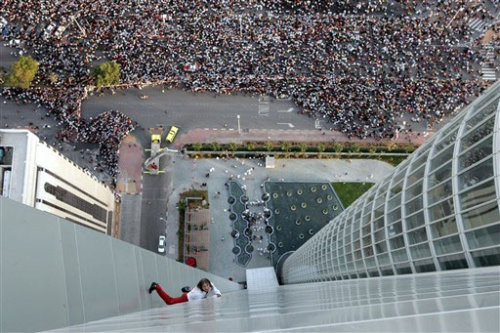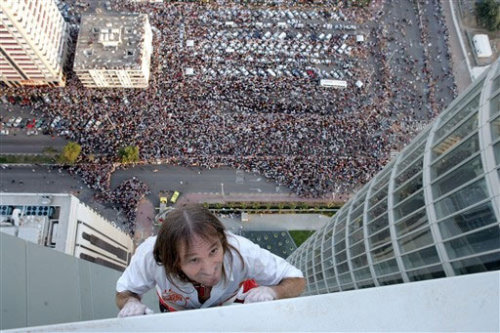'Vodka eyeballing', as it is known in student circles, is the latest drinking craze to sweep through Britain's universities.
Those who do it claim that it induces feelings of drunkenness at break-neck speeds, providing an instant high.
But the devastating long-term damage it causes is becoming a major concern among doctors and university authorities who already worry that Britain's student drinking culture is out of control.

Vodka Eyeballing : Doing Vodka Shots Through Your Eyes
Melissa, who left university last summer and is now 22, believes they are right to be worried. Her constantly watering left eye has been left permanently scarred by her antics. More worryingly still, she has been warned that her eyesight may deteriorate further as she gets older.
'I'm in constant pain because of what I did,' she says. 'And I'm terrified that it will get worse. I wish I could turn the clock back and change things. But I can't.'
It would be easy, of course, to dismiss Melissa as nothing more than a silly 'ladette'. But it is hard to reconcile that stereotype with the young woman she is today, fresh out of university in London with a first-class English degree, the privately-educated daughter of financiers, and an aspiring writer.
In short she is not the kind of young woman who might naturally be associated with Britain's spiralling binge-drinking youth culture.
The question is then, why would an intelligent, seemingly sensible woman do something so foolhardy and so grotesque as 'vodka eyeballing'. And what can be learnt from her story?
It is a question she wrestles with every day.

Crazy Drinking Habits: Vodka Eyeballing
'I know people will say that their son or daughter wouldn't do anything so stupid, but really I don't think parents have any idea what goes on at university and what pressures their children will come under to do stupid things,' says Melissa, who shares a flat with friends in South London.
'The student drinking culture has got completely out of hand and I know because I saw it. I regarded myself as a normal, sensible teenager, but I got pulled into it myself.'
She hasn't yet told her parents about her eye. 'I've put off telling them about it before now because I didn't want to worry them,' she says simply, but it's not hard to imagine how distressed they will be. Leaving home for the first time and going to university plunged Melissa into a world of almost unchecked social high-jinks.

vodka eyeballing craze that started in the U.S. and has now spread to the university party scene in Britain
'Being at university is like being in a bubble,' she claims. 'You live for the moment. It's very carefree. You want to try new things and don't think about what will happen afterwards.'
Looking back, she can see how she put common sense to one side as she tried to fit in with the other students.
The social environment at university was, she says, 'bawdy and competitive'. For those who did sports, it was even more so.
When she joined the netball team, she had no idea that her drinking skills off the court would be as scrutinised as her agility on it. Overnight, she found herself swiftly drawn into the university drinking culture.

Young people 'drinking' neat vodka alcohol Shot in eyes to get drunk

Vodka eyeball shots a dangerous way to imbibe Pictures
'It's especially difficult if you do sports because the element of competition you see in your game is transferred to the bar,' she says. 'I felt very pressured at the beginning. When we were travelling back from a game on the coach, there was a tradition whereby you had to down lots of port.'
The weekly 'Athletics Union' nights held in the Students' Union bar were even more depraved.
'The rugby players were the worst,' she says. 'But because of feminism, you're expected, as a woman, to keep up with them. The guys set a precedent and you have to follow. That's what drives the whole ladette culture. Women believing they have to be equal in every single way.'
What made matters worse for Melissa was that, by her own admission, she has always been highly competitive. It is a trait that in other areas of her life, her schooling, exams, has served her well.
Under the influence of alcohol, it was disastrous. Challenged to undergo a 'vodka eyeball', she was determined to impress her friends.
'Vodka eyeballing' is believed to have emerged as a dangerous trend in the U.S., where it is a popular nightclub trick performed by waitresses for tips in resorts such as Las Vegas.
Critics have also blamed the 2000 film Kevin And Perry Go Large, starring Harry Enfield as 'Kevin the Teenager', for encouraging the practice. In the film, actor Rhys Ifans plays a character called DJ Eyeball Paul, who performs the stunt in nightclubs.
While medical experts say it is still a relatively new phenomenon, a quick glance at the internet reveals how rife it has become among young drinkers in Britain.
The website YouTube, for example, features more than 800 clips of young men and women pouring vodka into their eyes - usually in their own homes. And these are just the ones stupid enough to film themselves and post their clips online.
Another woman I spoke to this week recalled seeing her former boss, a senior figure at a well-known advertising agency, 'drinking' vodka through his eye at an advertising party.
There are also pages on Facebook and other social networking sites set up by 'fans' of 'eyeballing', in which people seem to revel in the dramatic inebriation which seems to follow this dangerous practice.
In Scotland, concerns have been expressed by charities and campaign groups over a similar stunt using the highly alcoholic cinnamon-flavoured schnapps Aftershock instead of vodka.
Certainly, in recent years, ' eyeballing' has become a regular feature in university bars which are often run by students themselves and therefore difficult to police.
Melissa was partly reassured by the fact that many of her peers were doing it.
'I saw people I respected, intelligent students from normal, sensible backgrounds like me, behaving like this. I know it sounds stupid, but it made you feel it was OK. You felt that if other people were doing it with no serious side-effects, then somehow you were all right.
'I felt very buoyed up by everyone else. Your inhibitions have gone. It was exciting to push yourself.
'People will wonder why you'd do something so unpleasant to yourself, but it's almost a masochistic thing, a test of your endurance in front of your peers.' Not surprisingly, the pain was excruciating.
'It did sting. It was really painful. But bearing the pain is part of the competitiveness .'
Devotees claim that 'vodka eyeballing' induces drunkenness faster than drinking it can, because it passes easily through the mucous membrane and enters the bloodstream directly through veins at the back of the eye, although some experts are sceptical about the claims and believe that since those who do it are usually already drunk, they simply convince themselves that it's having such an effect.
Professor Robin Touquet, consultant in emergency medicine at St Mary's Hospital, Paddington, says: 'At 40 per cent pure ethanol, vodka in the eye would create inflammation and thrombosis - clotting of the blood vessels - such that very little alcohol would be absorbed. Unlike the stomach, the eye does not have a gastro-intestinal lining to protect it and aid absorption.
'I am absolutely horrified that someone would even think of putting vodka in their eye. It's self-abuse.
'In the past, vodka has been used as a disinfectant. At 40 per cent proof, imagine what it can do to an area as sensitive as the eye? It is highly toxic.
'Poured into the eye over a period of time, it could cause serious damage to both the cornea and the sclera, the white of the eye.'
Not surprisingly then, the following morning after her first 'vodka eyeball', Melissa's eye was severely bloodshot and sore.
'The pain went on for a long time, but I thought it was partly due to my hangover.' Nevertheless, she underwent the process again and again. In the weeks that followed, it became her party trick.
'I was very competitive,' she admits. 'Some people might do it once or twice - I did it quite a lot. I don't think I did more than three shots in a night, but I've got so much alcohol-related amnesia that I have completely blank periods of memory.'
On one level, of course, it is hard to comprehend how an intelligent young woman could be so irresponsible. But what is clear too is that Melissa's story is by no means unique.
'Vodka eyeballing was quite mainstream really,' she says. 'It went on all the time. Men and women were doing it. It was mostly the men, but the more competitive girls were trying to keep up with them. There was a sense that it was harmless fun. And although it was going on in the students' union bar, it was mostly run by students.'
It took only a month for Melissa to realise that she had damaged her eye. 'It got more and more sore and bloodshot,' she says. 'It was as if I had conjunctivitis all the time. It was sore and weepy, very sensitive. I was really frightened.'
Not surprisingly, her doctor was stunned when she went to see him. Melissa, who previously had perfect eyesight, was referred to an ophthalmologist, who told her that she had permanent scarring on the cornea of her left eye.
'She'd heard about vodka eyeballing going on in America, but she'd never seen a case in Britain,' says Melissa.
'She said vodka was so corrosive that it had literally seared its way through the cornea. But there was nothing she could do. You can't repair the cornea. I've been told it could lead to complications and can cause blindness, which is terrifying.
'At the moment, my vision is blurred in that eye, but that's because it's watering all the time. It's really sore and weepy. I've got used to the pain now. I just have to bear it. I don't think people can tell looking at me, but it is more bloodshot than the other one. It's never a clear white colour. It's hard to wear eye make-up because if anything goes in it, it's really painful and starts watering.'
Alarmingly, some of her friends have also suffered after-effects.
'I've told them to seek medical help, but they're too scared,' she says. Melissa is speaking out now because she wants to warn other students of the dangers and the pressures of the university drinking culture.
'The damage I've done to my eye is irrevocable. It's like someone damaging their liver. I really do want to get the message across,' she says.
She still drinks alcohol although never vodka, but keeps within the recommended NHS limits.
'I can't bear not feeling in control now,' she says. 'I hate the fact that there are nights out, periods of time that I simply can't remember.'
But there are also things that she can't forget.
And while most people are able to put their youthful misdemeanours behind them, Melissa is reminded of hers every day, with every blink of her eye.

























































